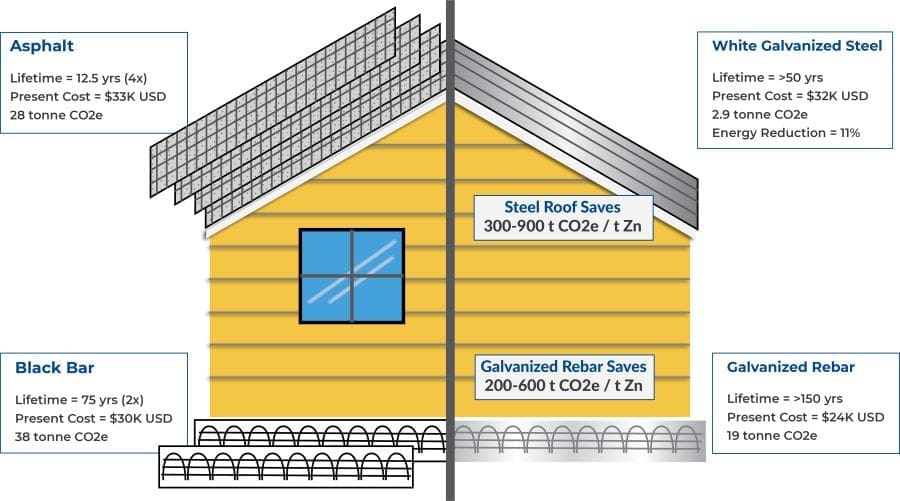Using zinc to build a single home prevents more than 50 tonnes in carbon emissions, and if just ten percent of new homes in North America were built using zinc, more than 40 million tonnes in carbon emissions would be prevented.
These impressive numbers demonstrating zinc’s success story as an agent of decarbonization are the first results of the International Zinc Association’s new Zinc Enables Decarbonization (ZED) initiative, a partnership between the International Zinc Association and Environmental Economist Benjamin Cox, Program Director of the Bradshaw Research Institute for Minerals and Mining at the University of British Columbia.
The ZED program quantifies zinc’s impact with steel on decreasing life-time costs, decreasing carbon emissions, and increasing safety in housing, infrastructure, energy and transportation. The first phase has assessed the value in residential construction, where zinc is used to coat and protect the rebar used in the reinforced concrete of a home’s foundation and in the sheeting of a metal roof. A zinc coating prevents corrosion and ensures longevity.

“Zinc plays a transformative role in building stronger, more sustainable communities, particularly in the decarbonization of residential buildings,” said Andrew Green, Executive Director of the International Zinc Association. “From the foundation to the rooftop, zinc enables long-lasting, low-maintenance solutions that enhance a home’s durability and environmental performance.”
In a typical U.S. home, a traditional foundation may last 75 years and an asphalt roof as long as 25 years, but a home using galvanized steel in concrete reinforcement and in roofing materials can double the service life and avert future costs and emissions associated with repair and replacement, according to ZED research. The selection of galvanized steel for new roofs in Europe also can prevent more than ten tonnes of carbon emissions per home and provide substantial economic savings over using tile roofing materials.
“Our research finds that zinc provides long-term savings by preventing repeated repair and replacement of a home’s roof and foundation,” said ZED Economist Benjamin Cox. “But in addition to economic savings, we’ve also accounted for the extraordinary environmental benefit provided by zinc – preventing hundreds of millions of tonnes in carbon emissions.”
The financial and environmental benefits are detailed in this graphic, showing the extended service life, lowered utility bill, and avoided environmental impact of a house built using zinc.
“Zinc’s impact in housing increases with each year of service life, adding substantial economic and environmental value to every home and providing a bright outlook for zinc and the homes it enhances,” said ZED Director Eric Van Genderen. “With these results, we can make the case to policy makers, investors, engineers, and builders to make zinc a permanent part of residential construction planning.”
The first report from the ZED program focuses on zinc’s impact on residential construction, particularly in the United States. ZED also will release reports quantifying zinc’s impact in transportation infrastructure, energy infrastructure, and the automotive industry.
***
The International Zinc Association is a non-profit trade association working on behalf of the global zinc industry and its downstream users. IZA’s mission is to provide global leadership, coordination, and value on strategic issues for the zinc industry, including market development, license to operate, communications, and sustainability.
Article Source:
Press Release/Material by International Zinc Association | For more info: Read (.pdf)
Featured image credit: jcomp | Freepik
Disclaimer:
This press release is not a document produced by Muser Press. Muser Press shall not bear responsibility for its content. In case you have any questions about this press release, please refer to the contact person/entity mentioned in the text of the press release.




